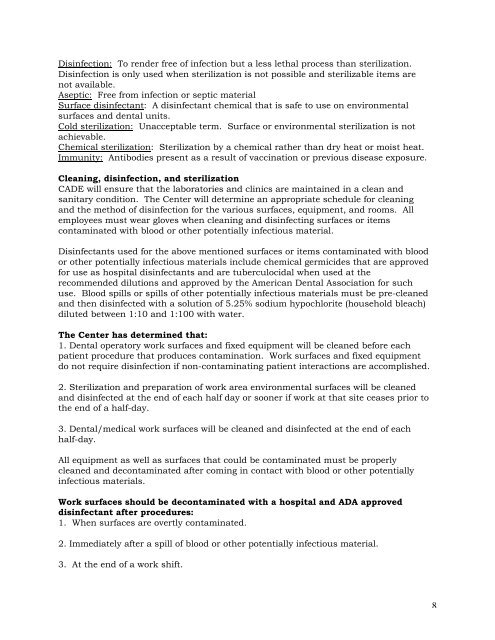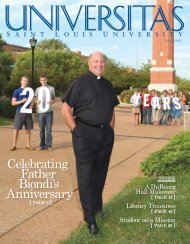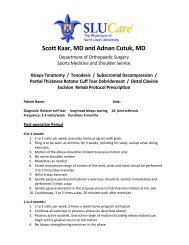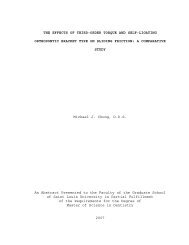Program Manual - Saint Louis University
Program Manual - Saint Louis University
Program Manual - Saint Louis University
You also want an ePaper? Increase the reach of your titles
YUMPU automatically turns print PDFs into web optimized ePapers that Google loves.
Disinfection: To render free of infection but a less lethal process than sterilization.<br />
Disinfection is only used when sterilization is not possible and sterilizable items are<br />
not available.<br />
Aseptic: Free from infection or septic material<br />
Surface disinfectant: A disinfectant chemical that is safe to use on environmental<br />
surfaces and dental units.<br />
Cold sterilization: Unacceptable term. Surface or environmental sterilization is not<br />
achievable.<br />
Chemical sterilization: Sterilization by a chemical rather than dry heat or moist heat.<br />
Immunity: Antibodies present as a result of vaccination or previous disease exposure.<br />
Cleaning, disinfection, and sterilization<br />
CADE will ensure that the laboratories and clinics are maintained in a clean and<br />
sanitary condition. The Center will determine an appropriate schedule for cleaning<br />
and the method of disinfection for the various surfaces, equipment, and rooms. All<br />
employees must wear gloves when cleaning and disinfecting surfaces or items<br />
contaminated with blood or other potentially infectious material.<br />
Disinfectants used for the above mentioned surfaces or items contaminated with blood<br />
or other potentially infectious materials include chemical germicides that are approved<br />
for use as hospital disinfectants and are tuberculocidal when used at the<br />
recommended dilutions and approved by the American Dental Association for such<br />
use. Blood spills or spills of other potentially infectious materials must be pre-cleaned<br />
and then disinfected with a solution of 5.25% sodium hypochlorite (household bleach)<br />
diluted between 1:10 and 1:100 with water.<br />
The Center has determined that:<br />
1. Dental operatory work surfaces and fixed equipment will be cleaned before each<br />
patient procedure that produces contamination. Work surfaces and fixed equipment<br />
do not require disinfection if non-contaminating patient interactions are accomplished.<br />
2. Sterilization and preparation of work area environmental surfaces will be cleaned<br />
and disinfected at the end of each half day or sooner if work at that site ceases prior to<br />
the end of a half-day.<br />
3. Dental/medical work surfaces will be cleaned and disinfected at the end of each<br />
half-day.<br />
All equipment as well as surfaces that could be contaminated must be properly<br />
cleaned and decontaminated after coming in contact with blood or other potentially<br />
infectious materials.<br />
Work surfaces should be decontaminated with a hospital and ADA approved<br />
disinfectant after procedures:<br />
1. When surfaces are overtly contaminated.<br />
2. Immediately after a spill of blood or other potentially infectious material.<br />
3. At the end of a work shift.<br />
8

















